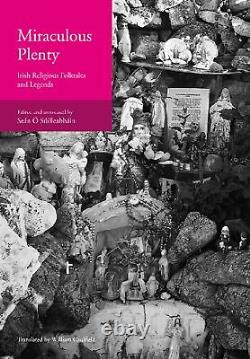
- Home
- Character
- Material
- Bone China (22)
- Brass, Crystal (7)
- Bronze (11)
- Cardboard, Paper (11)
- Ceramic (10)
- Ceramic & Porcelain (11)
- Ceramic, Porcelain (7)
- Crystal (506)
- Crystal, Glass (29)
- Glass (40)
- Gold (13)
- Lace (8)
- Lead Crystal (12)
- Linen (20)
- Metal (12)
- Paper (11)
- Pewter (7)
- Porcelain (104)
- Wood (15)
- Wool (7)
- ... (1189)
- Occasion
- Pattern
- Size
- Subject
Miraculous Plenty Irish Religious Folktales and Legends (20) Sc



For over 1,500 years, Ireland has been predominantly Christian. Religion has been a continuous force in various aspects of Irish life. As one might expect, a rich body of religious folktales and legends - both fanciful and credible - were part of the repertoire of the storyteller. Religious legends bring immediacy to traditions of the Holy Family, the Saints, and the Devil.
The stories in this book offer moral guidelines for a Christian life. The tradition was never fully oral and the influence of religious literature and church institutions is evident.
These tales vary in subject matter and include specifically Irish saint-lore, as well as more general tales of the Holy Family. The book contains a collection of 135 tales, including: the tale of'Saint Patrick and Crom Dubh,' which describes how the pagan Crom Dubh was converted to Christianity by St. Patrick, and how the last Sunday in July came to be known as'Domhnach Chrom Dubh' in recognition of this miraculous event. The tale'Our Lady's Visit,' which encompasses the concept of miraculous plenty as an international narrative, which tells of the house of a poor woman who is visited by the Mother of God in the guise of an old woman. In return for her kindness to the old woman, the woman of the house is given every kind of food she will ever need. These tales were first published in Irish in 1952, in an Ireland that was very different to the Ireland of today. The 135 tales were edited and annotated by Sean O Suilleabhin, who was then an archivist with the Irish Folklore Commission. He drew his material from the manuscript collection in what is today the National Folklore Collection at University College, Dublin. This beautifully designed book makes available, for the first time in English, an anthology of Irish religious folklore originally published in Gaelic in 1952. In describing his approach to translation, Caulfield writes that he'attempted to render the stories as (he) might have heard them told in English around (his) grandmother's hearth in sout-east Mayo in the 1940's, a place where Irish and English have sat side by side. In this he succeeds: the tales are readable and carry the rhythm and expression of Irish English.
